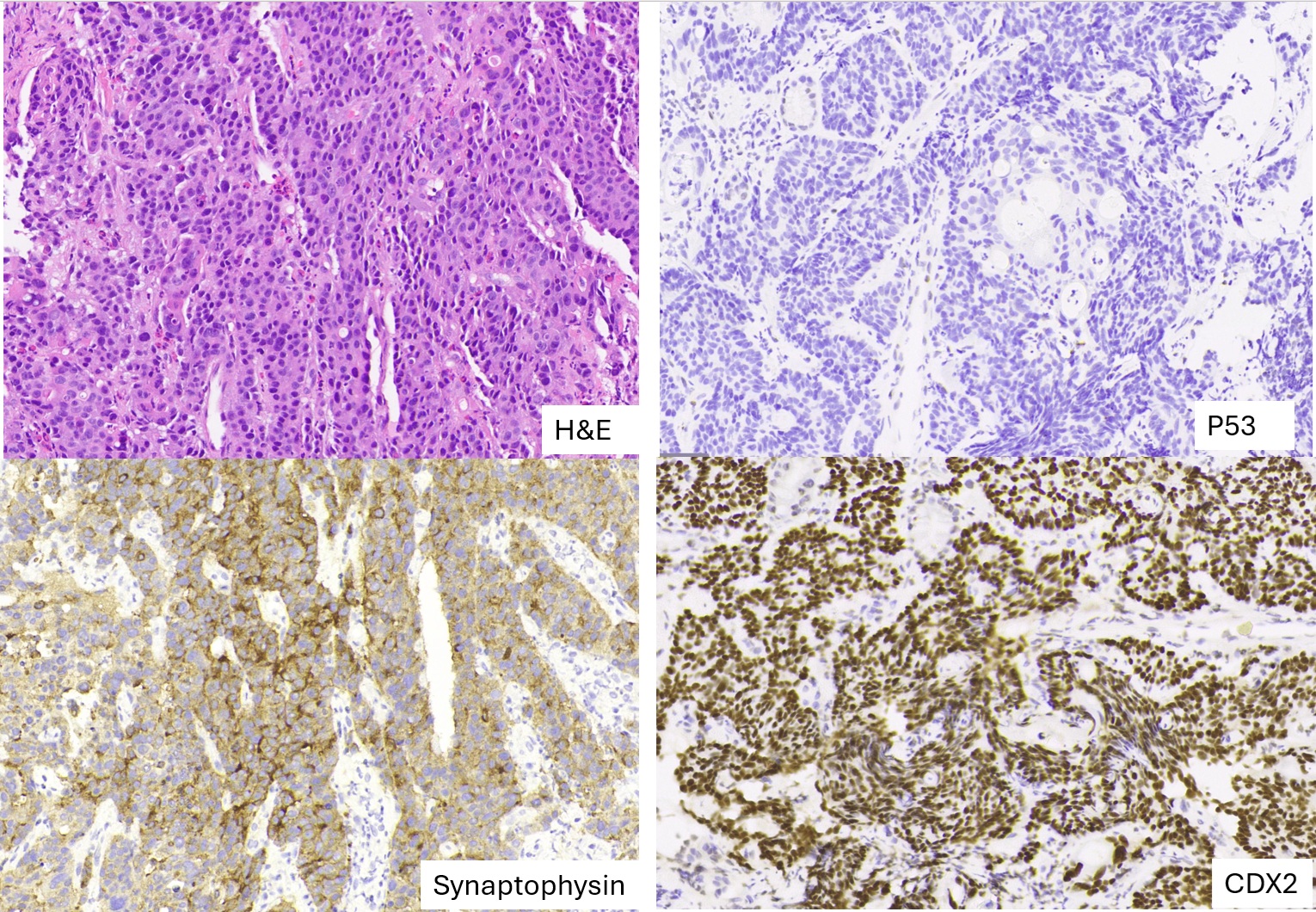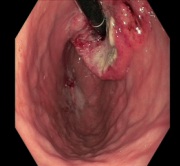Sunday Poster Session
Category: Stomach and Spleen
P2129 - Poorly Differentiated Adenocarcinoma with Neuroendocrine Differentiation of the Esophagogastric Junction: A Rare Case With Diagnostic and Management Challenges
Sunday, October 26, 2025
3:30 PM - 7:00 PM PDT
Location: Exhibit Hall

Nathaly S. Leon (she/her/hers)
Newtown Gastroenterology
Flushing, NY
Presenting Author(s)
Nathaly S. Leon, 1, Aaron Tin, 2, Kevin Tin, MD, MBA2
1Newtown Gastroenterology, Flushing, NY; 2Newtown Gastroenterology, Elmhurst, NY
Introduction: Cancers of the EGJ present diagnostic and therapeutic challenges due to their complex anatomical location and variable histology. Poorly differentiated adenocarcinoma with neuroendocrine differentiation (PD-ADC-NED) is a rare and aggressive tumor subtype, often misdiagnosed unless IHC staining is done. These mixed tumors may resemble or overlap with MiNENs (Mixed Neuroendocrine-Non-Neuroendocrine Neoplasms) and carry unique prognostic and management implications, particularly in elderly patients.
Case Description/
Methods: A 92-year-old Asian male presents for evaluation of dysphagia, abdominal distention, and melena. Laboratory results were compatible with anemia HB 7.4 and an elevated CEA 45.1. Cross-sectional imaging was performed, showing multiple hepatic masses highly suspicious for metastatic disease and positive retroperitoneal lymphadenopathy.
EGD revealed a large 5 cm mass at cardia with biopsies confirming poorly differentiated adenocarcinoma. Further IHC analysis demonstrated positive staining for synaptophysin, AE1/AE3, CDx2, p53, indicating neuroendocrine differentiation; but negative staining for chromogranin, S100 and CD56. The Ki-67 proliferation index exceeded 70%, consistent with a high-grade tumor. Additionally a strongly positive IHC was found for MLH1, PMS2 and MSH6 in 100% cells at the cardia area.
Given the patient’s advanced age, a multidisciplinary team recommended supportive care focused on chemotherapy and symptom control.
Discussion: Existing literature indicates that adenocarcinoma and neuroendocrine tumors require markedly different treatment approaches. Therefore, therapy should be tailored based on the predominant and most biologically aggressive component. PD-ADC-NED of the EGJ is rare and often underrecognized; its dual histology introduces diagnostic complexity and necessitates a tailored management strategy. Given its aggressive behavior and the lack of standardized guidelines, a multidisciplinary approach is essential—balancing therapeutic efficacy with patient age, performance status, and personal treatment preferences.
This case contributes to the limited but growing body of literature on EGJ tumors with neuroendocrine features. It underscores the urgent need for further research into standardized diagnostic criteria and therapeutic guidelines for PD-ADC-NED.

Figure: Tumor cells are arranged in sheets and nests, show a null-type p53 expression pattern, and are positive for synaptophysin and CDX2. The Ki-67 proliferation index exceeds 70%.

Figure: EGD image
Disclosures:
Nathaly Leon indicated no relevant financial relationships.
Aaron Tin indicated no relevant financial relationships.
Kevin Tin: Doctorpedia – Stock Options.
Nathaly S. Leon, 1, Aaron Tin, 2, Kevin Tin, MD, MBA2. P2129 - Poorly Differentiated Adenocarcinoma with Neuroendocrine Differentiation of the Esophagogastric Junction: A Rare Case With Diagnostic and Management Challenges, ACG 2025 Annual Scientific Meeting Abstracts. Phoenix, AZ: American College of Gastroenterology.
1Newtown Gastroenterology, Flushing, NY; 2Newtown Gastroenterology, Elmhurst, NY
Introduction: Cancers of the EGJ present diagnostic and therapeutic challenges due to their complex anatomical location and variable histology. Poorly differentiated adenocarcinoma with neuroendocrine differentiation (PD-ADC-NED) is a rare and aggressive tumor subtype, often misdiagnosed unless IHC staining is done. These mixed tumors may resemble or overlap with MiNENs (Mixed Neuroendocrine-Non-Neuroendocrine Neoplasms) and carry unique prognostic and management implications, particularly in elderly patients.
Case Description/
Methods: A 92-year-old Asian male presents for evaluation of dysphagia, abdominal distention, and melena. Laboratory results were compatible with anemia HB 7.4 and an elevated CEA 45.1. Cross-sectional imaging was performed, showing multiple hepatic masses highly suspicious for metastatic disease and positive retroperitoneal lymphadenopathy.
EGD revealed a large 5 cm mass at cardia with biopsies confirming poorly differentiated adenocarcinoma. Further IHC analysis demonstrated positive staining for synaptophysin, AE1/AE3, CDx2, p53, indicating neuroendocrine differentiation; but negative staining for chromogranin, S100 and CD56. The Ki-67 proliferation index exceeded 70%, consistent with a high-grade tumor. Additionally a strongly positive IHC was found for MLH1, PMS2 and MSH6 in 100% cells at the cardia area.
Given the patient’s advanced age, a multidisciplinary team recommended supportive care focused on chemotherapy and symptom control.
Discussion: Existing literature indicates that adenocarcinoma and neuroendocrine tumors require markedly different treatment approaches. Therefore, therapy should be tailored based on the predominant and most biologically aggressive component. PD-ADC-NED of the EGJ is rare and often underrecognized; its dual histology introduces diagnostic complexity and necessitates a tailored management strategy. Given its aggressive behavior and the lack of standardized guidelines, a multidisciplinary approach is essential—balancing therapeutic efficacy with patient age, performance status, and personal treatment preferences.
This case contributes to the limited but growing body of literature on EGJ tumors with neuroendocrine features. It underscores the urgent need for further research into standardized diagnostic criteria and therapeutic guidelines for PD-ADC-NED.

Figure: Tumor cells are arranged in sheets and nests, show a null-type p53 expression pattern, and are positive for synaptophysin and CDX2. The Ki-67 proliferation index exceeds 70%.

Figure: EGD image
Disclosures:
Nathaly Leon indicated no relevant financial relationships.
Aaron Tin indicated no relevant financial relationships.
Kevin Tin: Doctorpedia – Stock Options.
Nathaly S. Leon, 1, Aaron Tin, 2, Kevin Tin, MD, MBA2. P2129 - Poorly Differentiated Adenocarcinoma with Neuroendocrine Differentiation of the Esophagogastric Junction: A Rare Case With Diagnostic and Management Challenges, ACG 2025 Annual Scientific Meeting Abstracts. Phoenix, AZ: American College of Gastroenterology.
